The Geography of Social Media Data in Urban Areas: Representativeness and Complementarity
Abstract
:1. Introduction
2. Literature Review
2.1. Digital Data for Understanding Socioeconomic Urban Phenomena
2.2. Influence of Sociodemographic Characteristics on Social Media Data Generation
3. Case Study and Sources
3.1. Valencia as a Case Study City
3.2. Data Sources
3.2.1. Economic Data, Average Gross Income
3.2.2. Population Age
3.2.3. Social Networks Data
4. Method
- (i)
- Data were collected from diverse data sources, which included the statistical databases of the Spanish National Statistics Institute and the Spanish Tax Agency, as well as the selected social networks: Google Places, Foursquare, Twitter, Airbnb and Idealista.
- (ii)
- Data classification was carried out. Age groups were defined, data values were associated with their respective census section, and the land value was determined based on Airbnb and Idealista rental prices.
- (iii)
- Finally, two analytical and statistical techniques were used in order to find relationships between the location patterns of social network data and socioeconomic parameters. That is to say, partial methods were implemented to achieve the research objectives. First, all databases were visualized in a geographic information system and their location patterns were identified and compared; and second, a correlation study between all sources was performed.
4.1. Collection, Verification, and Visualization of Data Density
4.2. Data Classification
4.2.1. Population Density by Age-Range
4.2.2. Land Value and Average Income Distribution
4.3. Overlaying and Correlating LBSNs Data Layers with Economic and Demographic Determinants
5. Results
5.1. Population Density by Age-Range and Social Networks Data
5.2. Land Value, Average Income Distribution and Social Networks Data
5.3. Social Networks Data Density Comparison
6. Discussion
7. Concluding Remarks
Author Contributions
Funding
Institutional Review Board Statement
Informed Consent Statement
Data Availability Statement
Conflicts of Interest
References
- Martí, P.; Serrano-Estrada, L.; Nolasco-Cirugeda, A. Social Media data: Challenges, opportunities and limitations in urban studies. Comput. Environ. Urban Syst. 2019, 74, 161–174. [Google Scholar] [CrossRef]
- Martin, M.E.; Schuurman, N. Social Media Big Data Acquisition and Analysis for Qualitative GIScience: Challenges and Opportunities. Ann. Am. Assoc. Geogr. 2020, 110, 1335–1352. [Google Scholar] [CrossRef]
- Yang, D.; Qu, B.; Cudre-Mauroux, P. Location-Centric Social Media Analytics: Challenges and Opportunities for Smart Cities. IEEE Intell. Syst. 2020, 36, 3–10. [Google Scholar] [CrossRef]
- Carpio-Pinedo, J.; Gutiérrez, J. Consumption and symbolic capital in the metropolitan space: Integrating ‘old’ retail data sources with social big data. Cities 2020, 106, 102859. [Google Scholar] [CrossRef]
- Chen, T.; Hui, E.C.M.; Wu, J.; Lang, W.; Li, X. Identifying urban spatial structure and urban vibrancy in highly dense cities using georeferenced social media data. Habitat Int. 2019, 89, 102005. [Google Scholar] [CrossRef]
- Ebrahimpour, Z.; Wan, W.; Velázquez García, J.L.; Cervantes, O.; Hou, L. Analyzing Social-Geographic Human Mobility Patterns Using Large-Scale Social Media Data. ISPRS Int. J. Geo-Inf. 2020, 9, 125. [Google Scholar] [CrossRef] [Green Version]
- Latzko-Toth, G.; Bonneau, C.; Millette, M. Small Data, Thick Data: Thickening Strategies for Research, Trace-based Social Media. In The SAGE Handbook of Social Media Research Methods; Sloan, L., Quan-Haase, A., Eds.; SAGE Publications Ltd.: London, UK, 2017; pp. 199–212. ISBN 1473916321. [Google Scholar]
- Folch, D.C.; Spielman, S.E.; Manduca, R. Fast Food Data: Where User-Generated Content Works and Where It Does Not. Geogr. Anal. 2018, 50, 125–140. [Google Scholar] [CrossRef]
- Yuan, Y.; Lu, Y.; Chow, T.E.; Ye, C.; Alyaqout, A.; Liu, Y. The Missing Parts from Social Media–Enabled Smart Cities: Who, Where, When, and What? Ann. Am. Assoc. Geogr. 2020, 110, 462–475. [Google Scholar] [CrossRef]
- Fekete, E. Foursquare in the city of fountains: Using Kansas city as a case study for combining demographic and social media data. In Thinking Big Data in Geography: New Regimes, New Research; University of Nebraska Press: Lincoln, NE, USA, 2017; pp. 165–188. ISBN 9781496205377. [Google Scholar]
- Santani, D.; Gatica-Perez, D. Speaking swiss: Languages and venues in foursquare. In Proceedings of the MM 2013—2013 ACM Multimedia Conference, Barcelona, Spain, 22 October 2013; ACM Press: New York, NY, USA, 2013; pp. 501–504. [Google Scholar]
- Li, D.; Liu, J. Uncovering the relationship between point-of-interests-related human mobility and socioeconomic status. Telemat. Inform. 2019, 39, 49–63. [Google Scholar] [CrossRef]
- Dudás, G.; Vida, G.; Kovalcsik, T.; Boros, L. A socio-economic analysis of Airbnb in New York City. Reg. Stat. 2017, 7, 135–151. [Google Scholar] [CrossRef]
- Longley, P.A.; Adnan, M.; Lansley, G. The geotemporal demographics of Twitter usage. Environ. Plan. A 2015, 47, 465–484. [Google Scholar] [CrossRef]
- Murthy, D.; Gross, A.; Pensavalle, A. Urban Social Media Demographics: An Exploration of Twitter Use in Major American Cities. J. Comput. Commun. 2016, 21, 33–49. [Google Scholar] [CrossRef] [Green Version]
- Jiang, Y.; Li, Z.; Ye, X. Understanding demographic and socioeconomic biases of geotagged Twitter users at the county level. Cartogr. Geogr. Inf. Sci. 2019, 46, 228–242. [Google Scholar] [CrossRef]
- Lerman, K.; Arora, M.; Gallegos, L.; Kumaraguru, P.; Garcia, D. Emotions, demographics and sociability in Twitter interactions. In Proceedings of the 10th International Conference on Web and Social Media, ICWSM 2016, Cologne, Germany, 17–20 May 2016; pp. 201–210. [Google Scholar]
- White, R.; Engelen, G.; Uljee, I. Modeling Cities and Regions as Complex Systems; MIT Press: Cambridge, MA, USA, 2015; ISBN 9780262029568. [Google Scholar]
- Pinheiro Gawryszewski, V.; Scarlazzari Costa, L. Homicídios e desigualdades sociais no Município de São Paulo. Rev. Saude Publica 2005, 39, 191–197. [Google Scholar] [CrossRef] [PubMed] [Green Version]
- Marquet, O.; Miralles-Guasch, C. Walking short distances. The socioeconomic drivers for the use of proximity in everyday mobility in Barcelona. Transp. Res. Part A Policy Pract. 2014, 70, 210–222. [Google Scholar] [CrossRef]
- Grujic, N.; Brdar, S.; Novovic, O.; Govedarica, M.; Crnojevic, V. Evidence of urban segregation from mobile phone data: A case study of Novi Sad. In Proceedings of the 27th Telecommunications Forum, TELFOR 2019, Belgrade, Serbia, 26–27 November 2019; Institute of Electrical and Electronics Engineers Inc.: Piscataway, NJ, USA, 2019. [Google Scholar]
- Tu, W.; Zhu, T.; Xia, J.; Zhou, Y.; Lai, Y.; Jiang, J.; Li, Q. Portraying the spatial dynamics of urban vibrancy using multisource urban big data. Comput. Environ. Urban Syst. 2020, 80, 101428. [Google Scholar] [CrossRef]
- Frias-Martinez, V.; Virseda, J. On the relationship between socio-economic factors and cell phone usage. In ACM International Conference Proceeding Series; ACM Press: New York, NY, USA, 2012; pp. 76–84. [Google Scholar]
- Yardi, S.; Bruckman, A. Income, race, and class: Exploring socioeconomic differences in family technology use. In Conference on Human Factors in Computing Systems—Proceedings; ACM Press: New York, NY, USA, 2012; pp. 3041–3050. [Google Scholar]
- Penard, T.; Poussing, N.; Yebe, G.Z. Comparing the Determinants of Internet and Cell Phone Use in Africa: Evidence from Gabon. Commun. Strateg. 2012, 1, 65–83. [Google Scholar]
- Deville, P.; Linard, C.; Martin, S.; Gilbert, M.; Stevens, F.R.; Gaughan, A.E.; Blondel, V.D.; Tatem, A.J. Dynamic population mapping using mobile phone data. Proc. Natl. Acad. Sci. USA 2014, 111, 15888–15893. [Google Scholar] [CrossRef] [Green Version]
- Bayir, M.A.; Demirbas, M.; Eagle, N. Mobility profiler: A framework for discovering mobility profiles of cell phone users. Pervasive Mob. Comput. 2010, 6, 435–454. [Google Scholar] [CrossRef]
- Demissie, M.G.; Phithakkitnukoon, S.; Sukhvibul, T.; Antunes, F.; Gomes, R.; Bento, C. Inferring Passenger Travel Demand to Improve Urban Mobility in Developing Countries Using Cell Phone Data: A Case Study of Senegal. IEEE Trans. Intell. Transp. Syst. 2016, 17, 2466–2478. [Google Scholar] [CrossRef]
- Smoreda, Z.; Olteanu-Raimond, A.-M.; Couronné, T. Spatiotemporal Data from Mobile Phones for Personal Mobility Assessment. In Transport Survey Methods: Best Practice for Decision Making; Emerald Group Publishing Ltd.: Bingley, UK, 2013; pp. 745–768. [Google Scholar]
- Osorio Arjona, J.; García Palomares, J.C. Nuevas fuentes y retos para el estudio de la movilidad urbana. Cuad. Geográficos 2017, 56, 247–267. [Google Scholar]
- Li, H.; Wei, Y.D.; Wu, Y.; Tian, G. Analyzing housing prices in Shanghai with open data: Amenity, accessibility and urban structure. Cities 2019, 91, 165–179. [Google Scholar] [CrossRef]
- Ye, Y.; Xie, H.; Fang, J.; Jiang, H.; Wang, D. Daily Accessed Street Greenery and Housing Price: Measuring Economic Performance of Human-Scale Streetscapes via New Urban Data. Sustainability 2019, 11, 1741. [Google Scholar] [CrossRef] [Green Version]
- Shen, Y.; Karimi, K. Urban function connectivity: Characterisation of functional urban streets with social media check-in data. Cities 2016, 55, 9–21. [Google Scholar] [CrossRef] [Green Version]
- Ballatore, A.; De Sabbata, S. Los Angeles as a digital place: The geographies of user-generated content. Trans. GIS 2020, 24, 880–902. [Google Scholar] [CrossRef]
- Rizwan, M.; Wanggen, W.; Gwiazdzinski, L. Visualization, Spatiotemporal Patterns, and Directional Analysis of Urban Activities Using Geolocation Data Extracted from LBSN. ISPRS Int. J. Geo-Inf. 2020, 9, 137. [Google Scholar] [CrossRef] [Green Version]
- Muhammad, R.; Zhao, Y.; Liu, F. Spatiotemporal Analysis to Observe Gender Based Check-In Behavior by Using Social Media Big Data: A Case Study of Guangzhou, China. Sustainability 2019, 11, 2822. [Google Scholar] [CrossRef] [Green Version]
- Shelton, T.; Poorthuis, A.; Zook, M. Social media and the city: Rethinking urban socio-spatial inequality using user-generated geographic information. Landsc. Urban Plan. 2015, 142, 198–211. [Google Scholar] [CrossRef]
- Jaidka, K.; Guntuku, S.C.; Lee, J.H.; Luo, Z.; Buffone, A.; Ungar, L.H. The rural–urban stress divide: Obtaining geographical insights through Twitter. Comput. Human Behav. 2020, 114, 106544. [Google Scholar] [CrossRef]
- Salas-Olmedo, M.H.; Moya-Gómez, B.; García-Palomares, J.C.; Gutiérrez, J. Tourists’ digital footprint in cities: Comparing Big Data sources. Tour. Manag. 2018, 66, 13–25. [Google Scholar] [CrossRef] [Green Version]
- Blanford, J.I.; Huang, Z.; Savelyev, A.; MacEachren, A.M. Geo-located tweets. Enhancing mobility maps and capturing cross-border movement. PLoS ONE 2015, 10, e0129202. [Google Scholar] [CrossRef] [Green Version]
- Blank, G.; Lutz, C. Representativeness of Social Media in Great Britain: Investigating Facebook, LinkedIn, Twitter, Pinterest, Google+, and Instagram. Am. Behav. Sci. 2017, 61, 741–756. [Google Scholar] [CrossRef]
- Laman, H.; Eluru, N.; Yasmin, S. Using location-based social network data for activity intensity analysis. J. Transp. Land Use 2019, 12, 723–740. [Google Scholar] [CrossRef]
- Hu, W. Dynamic Origin Destination Estimation with Location-Based; The state University of New Jersey: New Brunswick, NJ, USA, 2019. [Google Scholar] [CrossRef]
- Khan, N.U.; Wan, W.; Yu, S. Location-Based Social Network’s Data Analysis and Spatio-Temporal Modeling for the Mega City of Shanghai, China. ISPRS Int. J. Geo-Inf. 2020, 9, 76. [Google Scholar] [CrossRef] [Green Version]
- Gutiérrez, J.; García-Palomares, J.C.; Romanillos, G.; Salas-Olmedo, M.H. The eruption of Airbnb in tourist cities: Comparing spatial patterns of hotels and peer-to-peer accommodation in Barcelona. Tour. Manag. 2017, 62, 278–291. [Google Scholar] [CrossRef] [Green Version]
- Instituto Nacional de Estadística Padrón. Población por Municipios. Available online: https://www.ine.es/dyngs/INEbase/categoria.htm?c=Estadistica_P&cid=1254734710990 (accessed on 28 September 2021).
- OECD. Stat- Metropolitan Areas. Available online: https://stats.oecd.org/ (accessed on 11 August 2020).
- GaWC—Globalization and World Cities Research Network the World According to GaWC. Available online: https://www.lboro.ac.uk/gawc/ (accessed on 28 September 2021).
- Gil-Alonso, F.; López-Villanueva, C.; Bayona-i-Carrasco, J.; Pujadas, I. Towards an Even More Spatially Diversified City? New Metropolitan Population Trends in the Post-Economic Crisis Period. Urban Sci. 2021, 5, 41. [Google Scholar] [CrossRef]
- Guadalajara, N.; López, M.Á.; Iftimi, A.; Usai, A. Influence of the cadastral value of the urban land and neighborhood characteristics on the mean house mortgage appraisal. Land 2021, 10, 250. [Google Scholar] [CrossRef]
- Serra, P.; Vera, A.; Tulla, A.F.; Salvati, L. Beyond urban–rural dichotomy: Exploring socioeconomic and land-use processes of change in Spain (1991–2011). Appl. Geogr. 2014, 55, 71–81. [Google Scholar] [CrossRef]
- Instituto Nacional de Estadística. Encuesta de Ocupación Hotelera. Available online: https://www.ine.es/dynt3/inebase/es/index.htm?padre=238&dh=1 (accessed on 28 September 2021).
- Instituto Nacional de Estadística. Encuesta de Ocupación de Alojamientos Turísticos. Available online: https://www.ine.es/dyngs/INEbase/es/operacion.htm?c=Estadistica_C&cid=1254736176962&menu=ultiDatos&idp=1254735576863 (accessed on 28 September 2021).
- Adamiak, C.; Szyda, B.; Dubownik, A.; García-Álvarez, D. Airbnb Offer in Spain—Spatial Analysis of the Pattern and Determinants of Its Distribution. ISPRS Int. J. Geo-Inf. 2019, 8, 155. [Google Scholar] [CrossRef] [Green Version]
- García-Amaya, A.M.; Temes-Cordovez, R.; Simancas-Cruz, M.; Peñarrubia-Zaragoza, M.P. The Airbnb effect on areas subject to urban renewal in Valencia (Spain). Int. J. Tour. Cities 2021, 7, 361–390. [Google Scholar] [CrossRef]
- Nieuwland, S.; del Romero Renau, L. The impact and regulatory issues of Airbnb in a mid-sized city: Valencia (Spain). In A Modern Guide to the Urban Sharing Economy; Edward Elgar Publishing: Northampton, MA, USA, 2021; pp. 103–118. [Google Scholar] [CrossRef]
- IAB. Estudio Anual Redes Sociales 2020; IAB Spain: Madrid, Spain, 2020; p. 71. [Google Scholar]
- The Social Media Family. VI Estudio sobre los Usuarios de Facebook, Twitter e Instagram en España. Available online: https://www.amic.media/media/files/file_352_2282.pdf (accessed on 28 September 2021).
- Gallego, C.Z.; Carrasco, J.S. Geolocalized tweets for assessing daily mobility: Methodology to analyse and detect homelocation in the urban area of Valencia. Bol. Asoc. Geogr. Esp. 2018, 79, 2464. [Google Scholar] [CrossRef]
- E. Life Monitor. Uso de Foursquare en España. Available online: https://t-position.com/el-uso-de-foursquare-en-espana-infografia/ (accessed on 28 September 2021).
- AirDNA|Short-Term Rental Data & Analytics|Vrbo & Airbnb Data. Available online: https://www.airdna.co/ (accessed on 10 June 2021).
- Hosteltur. Las 8 Ciudades de España Donde más ha Crecido Airbnb|Hoteles y Alojamientos. Available online: https://www.hosteltur.com/127379_8-ciudades-espana-donde-ha-crecido-airbnb.html (accessed on 28 September 2021).
- Martí, P.; Serrano-Estrada, L.; Nolasco-Cirugeda, A. Using locative social media and urban cartographies to identify and locate successful urban plazas. Cities 2017, 64, 66–78. [Google Scholar] [CrossRef]
- Arribas-Bel, D.; Bakens, J. Use and validation of location-based services in urban research: An example with Dutch restaurants. Urban Stud. 2019, 56, 868–884. [Google Scholar] [CrossRef]
- Martí, P.; García-Mayor, C.; Serrano-Estrada, L. Identifying opportunity places for urban regeneration through LBSNs. Cities 2019, 90, 191–206. [Google Scholar] [CrossRef]
- Zervas, G.; Proserpio, D.; Byers, J.W. The Rise of the Sharing Economy: Estimating the Impact of Airbnb on the Hotel Industry. J. Mark. Res. 2017, 54, 687–705. [Google Scholar] [CrossRef] [Green Version]
- Sans, A.A.; Quaglieri, A. Unravelling Airbnb: Urban perspectives from Barcelona. In Reinventing the Local in Tourism: Producing, Consuming and Negotiating Place; Channel View Publications: Bristol, UK, 2016; pp. 209–228. [Google Scholar]
- Domínguez, M.; Vilà, G. Los centros urbanos de las grandes ciudades españolas: Una perspectiva demográfica y urbanística. Los casos de de Madrid y Barcelona. In Actas del XI Congreso Español de Sociología; Universidad Complutense de Madrid: Madrid, España, 2013; pp. 166–181. [Google Scholar]
- Donat, C. El impacto desigual de la crisis inmobiliaria en los barrios de Barcelona: Un análisis a partir de los precios de las viviendas. In Nuevos Escenarios Urbanos Nuevos Conflictos y Nuevas Políticas. XIII Coloquio de Geografía Urbana; Documenta Universitaria: Girona, España, 2017; pp. 14–28. [Google Scholar]
- García-Palomares, J.C.; Salas-Olmedo, M.H.; Moya-Gómez, B.; Condeço-Melhorado, A.; Gutiérrez, J. City dynamics through Twitter: Relationships between land use and spatiotemporal demographics. Cities 2018, 72, 310–319. [Google Scholar] [CrossRef]
- Osorio-Arjona, J.; García-Palomares, J.C. Social media and urban mobility: Using twitter to calculate home-work travel matrices. Cities 2019, 89, 268–280. [Google Scholar] [CrossRef]
- Schreck, T.; Keim, D. Visual analysis of social media data. Computer 2013, 46, 68–75. [Google Scholar] [CrossRef]
- Bernabeu-Bautista, Á.; Serrano-Estrada, L.; Martí, P. Social Media Data Collection and Quality for Urban Studies. In Principles of Social Networking. The New Horizon and Emerging Challenges; Springer: Singapore, 2021; pp. 229–248. [Google Scholar]
- Huang, Q.; Wong, D.W.S. Activity patterns, socioeconomic status and urban spatial structure: What can social media data tell us? Int. J. Geogr. Inf. Sci. 2016, 30, 1873–1898. [Google Scholar] [CrossRef]
- Instituto Geográfico Nacional. Capítulo 9. Sociedad. In España en Mapas. Una Síntesis Geográfica; Centro Nacional de Información Geográfica: Madrid, España, 2019; pp. 228–247. ISBN 9788441648456. [Google Scholar]
- McMillan, D.; Engström, A.; Lampinen, A.; Brown, B. Data and the city. In Proceedings of the 2016 CHI Conference on Human Factors in Computing Systems, San Jose, CA, USA, 7–12 May 2016; pp. 2933–2944. [Google Scholar] [CrossRef]
- Offenhuber, D.; Ratti, C. Decoding the City: Urbanism in the Age of Big Data; Birkhäuser: Basilea, Switzerland, 2015; ISBN 978-3038215974. [Google Scholar]
- Kovacs-györi, A.; Ristea, A.; Havas, C.; Mehaffy, M.; Hochmair, H.H.; Resch, B.; Juhasz, L.; Lehner, A.; Ramasubramanian, L.; Blaschke, T. Opportunities and Challenges of Geospatial Analysis for Promoting Urban Livability in the Era of Big Data and Machine Learning. Int. J. Geo-Inf. 2020, 9, 752. [Google Scholar] [CrossRef]
- Milias, V.; Psyllidis, A. Assessing the influence of point-of-interest features on the classification of place categories. Comput. Environ. Urban Syst. 2021, 86, 101597. [Google Scholar] [CrossRef]
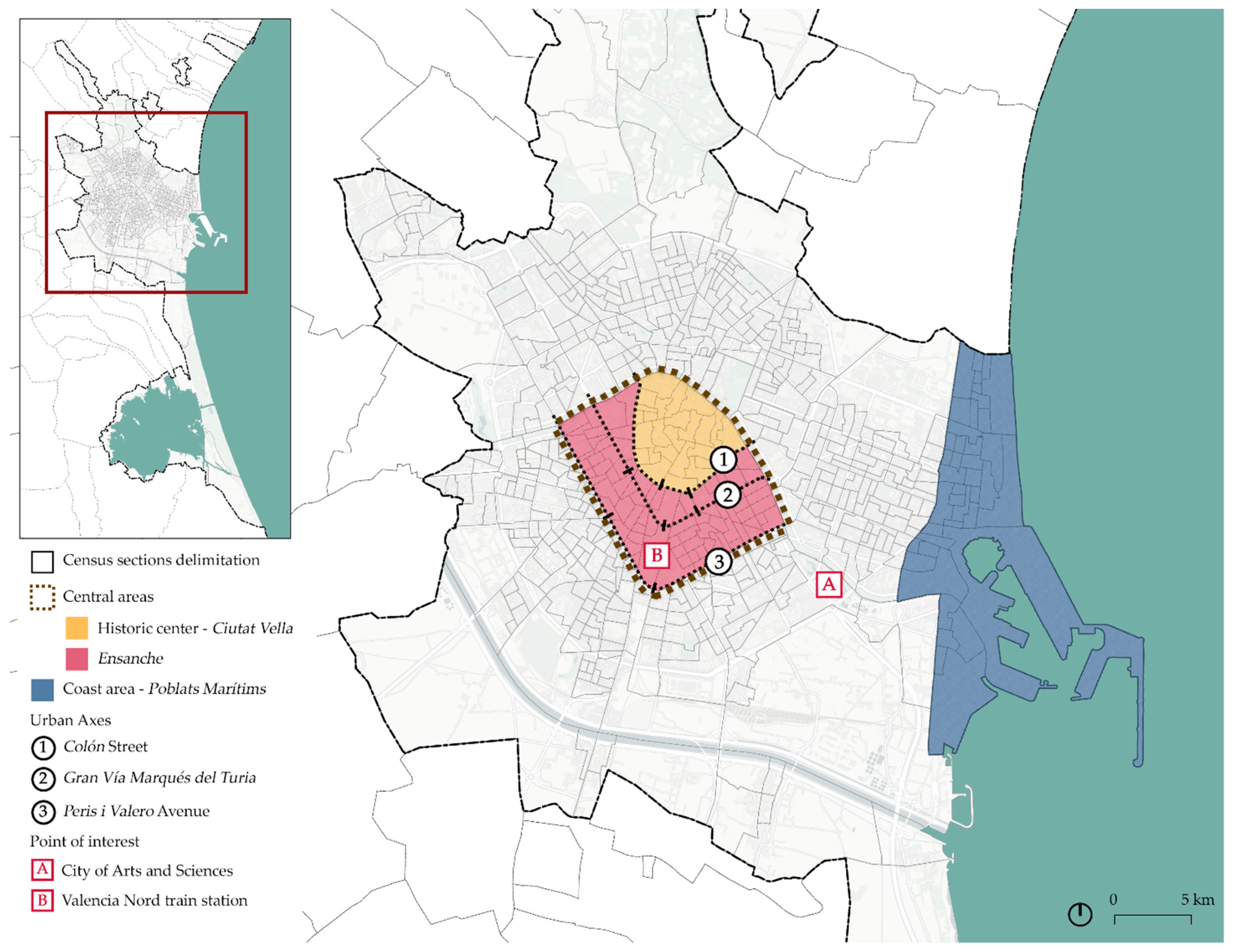


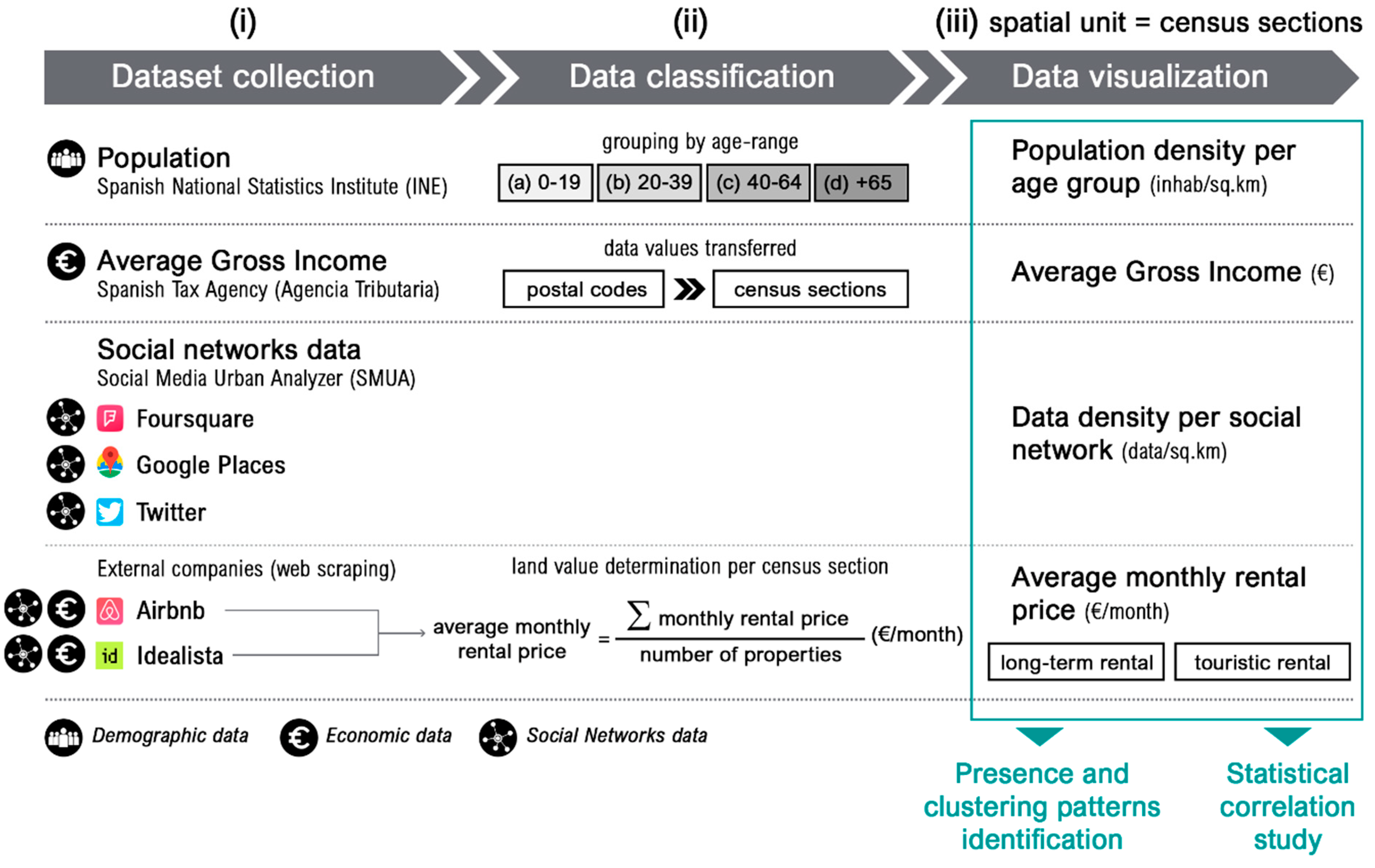

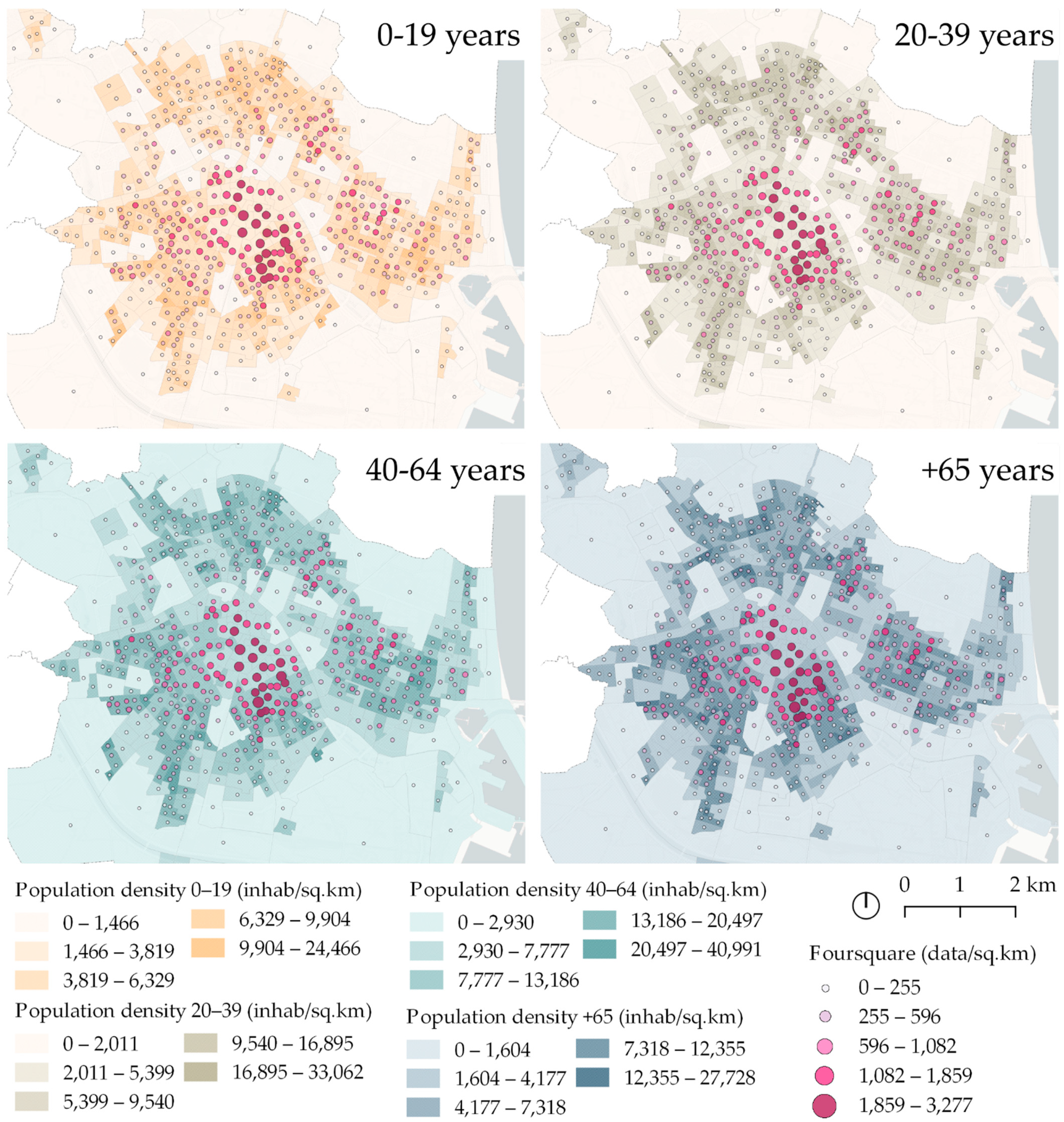

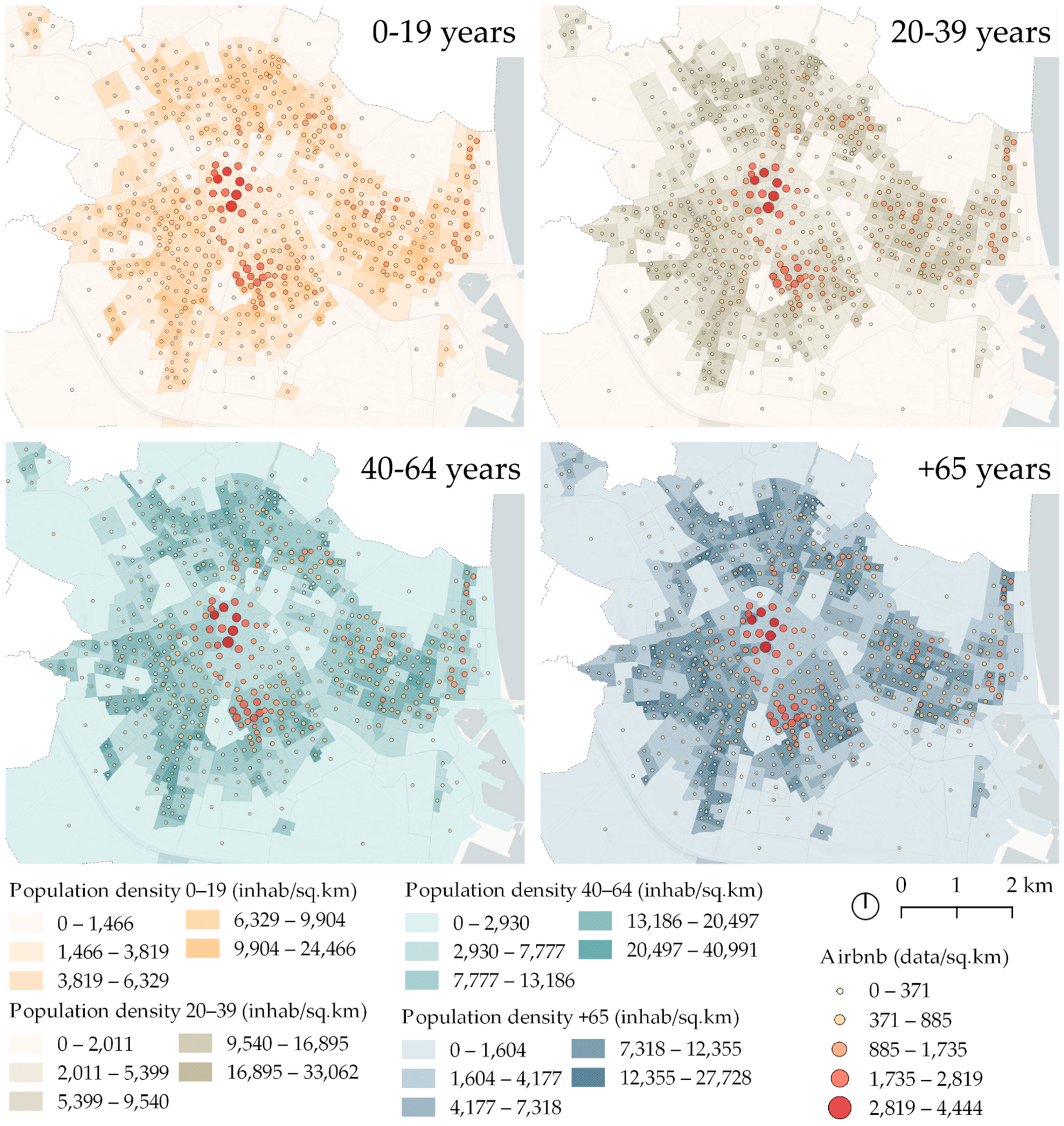

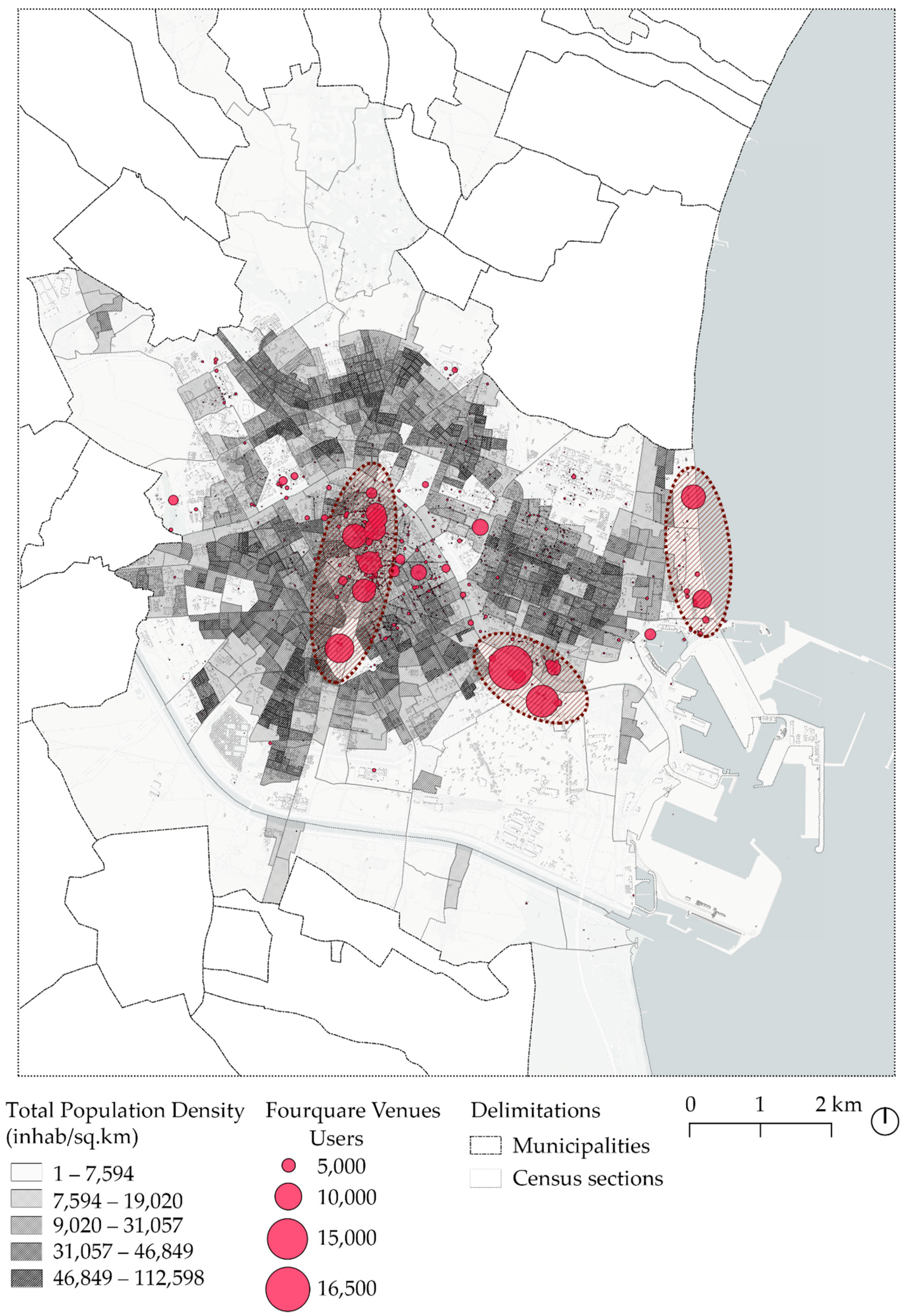
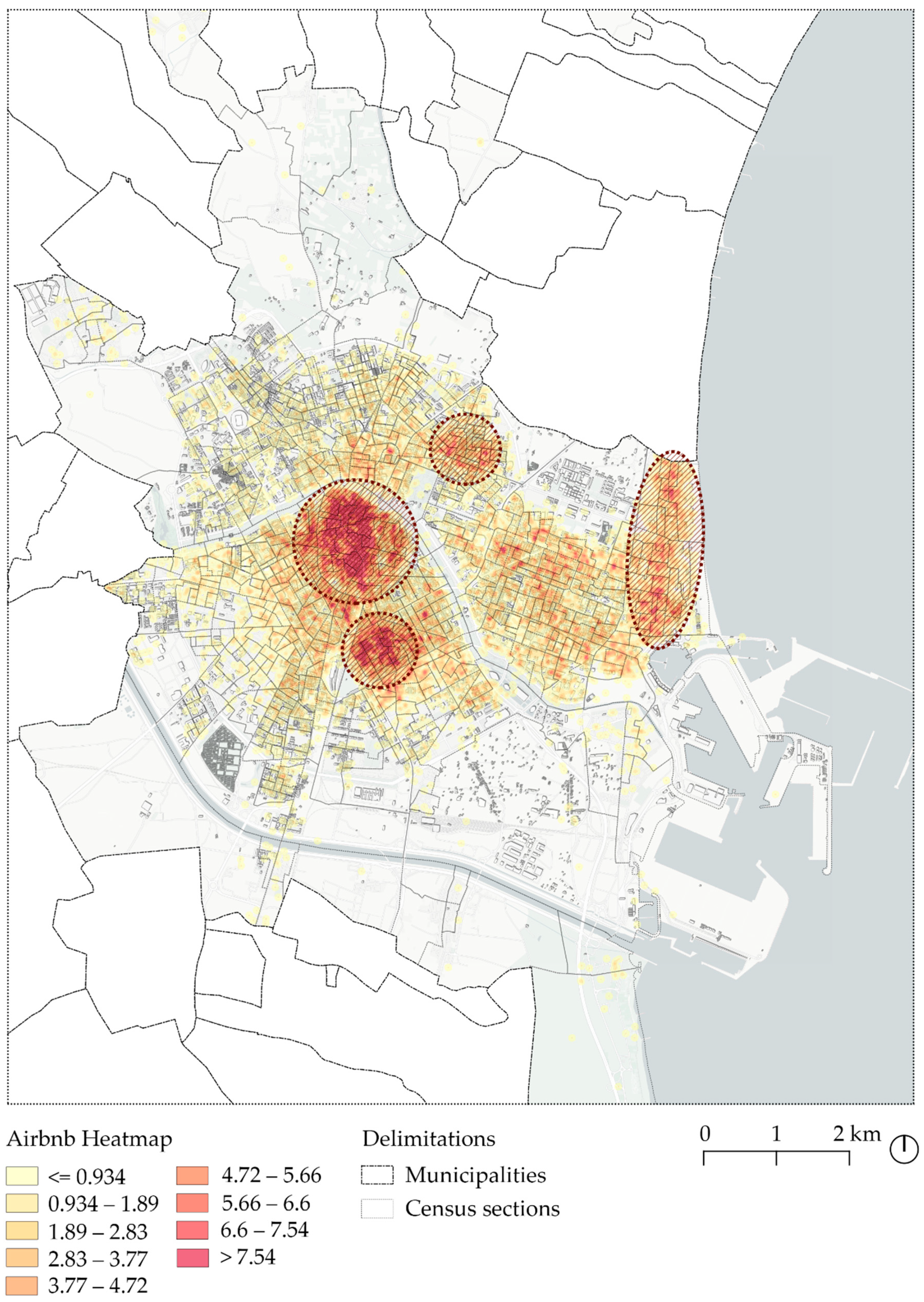
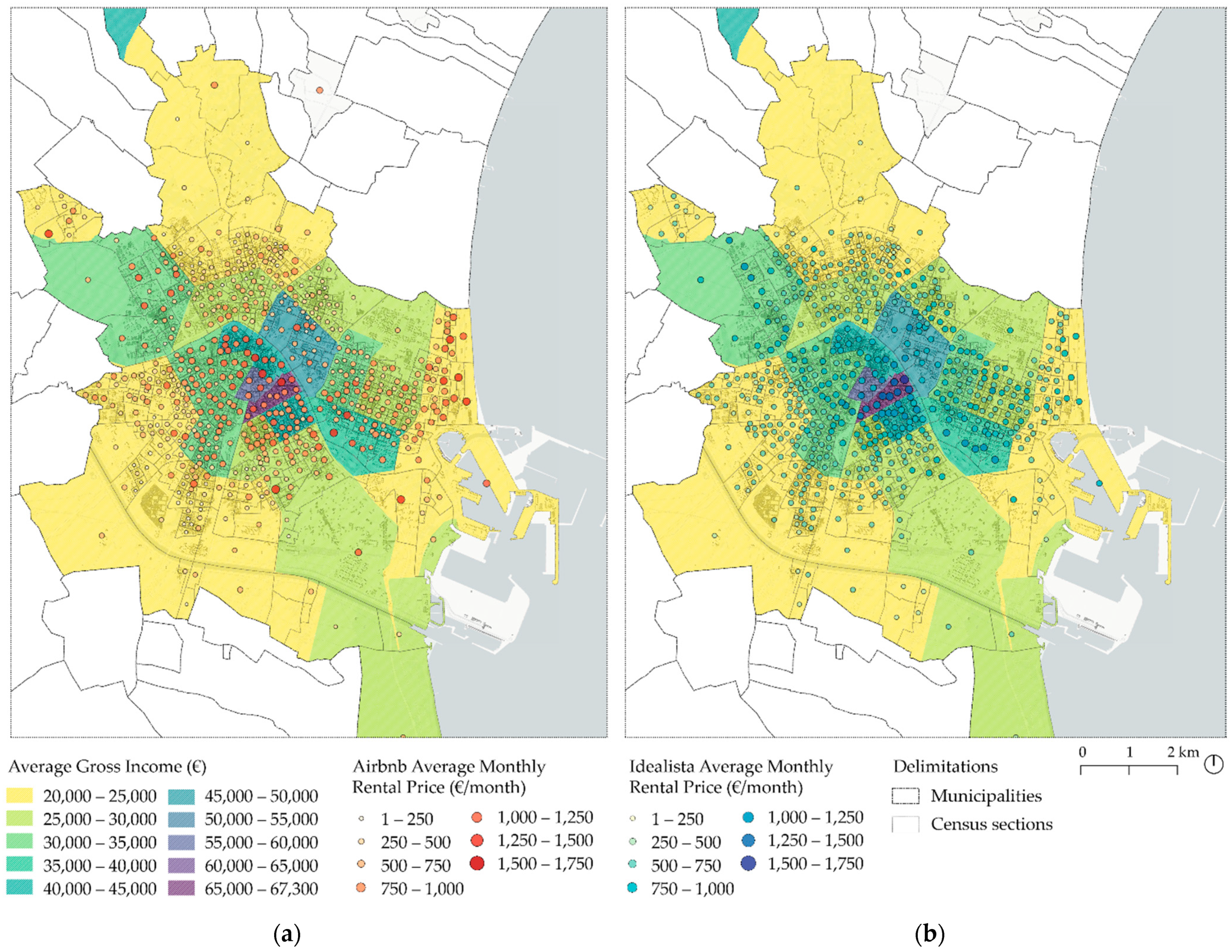

| Foursquare | Google Places | Airbnb | Idealista | ||
|---|---|---|---|---|---|
| Variables used for this study | Geographic coordinates | Geographic coordinates | Geographic coordinates | Geographic coordinates | Geographic coordinates |
| Venue address | Place address | Location of tweets (if shared by users) | Listing address | Listing address | |
| Venue ID | Place ID | Tweet ID | Listing ID | Listing ID | |
| Name of venue | Name of place | Textual content | Listing price per month | Listing price per month | |
| Number of registered users per venue | - | - | - | - |
| INE Total Population | Age < 19 | Age 20–39 | Age 40–64 | Age > 65 | Google Places | Foursquare | Airbnb | Idealista | Rental Idealista | Rental Airbnb | ||
|---|---|---|---|---|---|---|---|---|---|---|---|---|
| age < 19 | 0.883 ** | |||||||||||
| age 20–39 | 0.910 ** | 0.750 ** | ||||||||||
| age 40–64 | 0.967 ** | 0.881** | 0.835 ** | |||||||||
| age > 65 | 0.538 ** | 0.188 ** | 0.424 ** | 0.412 ** | ||||||||
| Google Places | 0.100 * | 0.072 | 0.067 | 0.086 * | 0.129 ** | |||||||
| Foursquare | 0.060 | 0.053 | 0.040 | 0.050 | 0.069 | 0.886 ** | ||||||
| 0.067 | 0.076 | 0.081 * | 0.071 | −0.027 | 0.603 ** | 0.566 ** | ||||||
| Airbnb | 0.012 | −0.039 | 0.083 * | 0.015 | −0.031 | 0.627 ** | 0.625 ** | 0.518 ** | ||||
| Idealista | 0.339 ** | 0.326 ** | 0.352 ** | 0.321 ** | 0.103 * | 0.587 ** | 0.540 ** | 0.471 ** | 0.506 ** | |||
| Rental Idealista | −0.074 | 0.008 | −0.114 ** | −0.074 | −0.070 | 0.489 ** | 0.529 ** | 0.273 ** | 0.375 ** | 0.231 ** | ||
| Rental Airbnb | −0.040 | 0.010 | −0.063 | −0.049 | −0.026 | 0.346 ** | 0.334 ** | 0.253 ** | 0.451 ** | 0.264 ** | 0.431 ** | |
| Income | −0.167 ** | −0.130 ** | −0.192 ** | −0.186 ** | −0.008 | 0.576 ** | 0.585 ** | 0.276 ** | 0.360 ** | 0.203 ** | 0.684 ** | 0.334 ** |
Publisher’s Note: MDPI stays neutral with regard to jurisdictional claims in published maps and institutional affiliations. |
© 2021 by the authors. Licensee MDPI, Basel, Switzerland. This article is an open access article distributed under the terms and conditions of the Creative Commons Attribution (CC BY) license (https://creativecommons.org/licenses/by/4.0/).
Share and Cite
Bernabeu-Bautista, Á.; Serrano-Estrada, L.; Perez-Sanchez, V.R.; Martí, P. The Geography of Social Media Data in Urban Areas: Representativeness and Complementarity. ISPRS Int. J. Geo-Inf. 2021, 10, 747. https://doi.org/10.3390/ijgi10110747
Bernabeu-Bautista Á, Serrano-Estrada L, Perez-Sanchez VR, Martí P. The Geography of Social Media Data in Urban Areas: Representativeness and Complementarity. ISPRS International Journal of Geo-Information. 2021; 10(11):747. https://doi.org/10.3390/ijgi10110747
Chicago/Turabian StyleBernabeu-Bautista, Álvaro, Leticia Serrano-Estrada, V. Raul Perez-Sanchez, and Pablo Martí. 2021. "The Geography of Social Media Data in Urban Areas: Representativeness and Complementarity" ISPRS International Journal of Geo-Information 10, no. 11: 747. https://doi.org/10.3390/ijgi10110747
APA StyleBernabeu-Bautista, Á., Serrano-Estrada, L., Perez-Sanchez, V. R., & Martí, P. (2021). The Geography of Social Media Data in Urban Areas: Representativeness and Complementarity. ISPRS International Journal of Geo-Information, 10(11), 747. https://doi.org/10.3390/ijgi10110747









